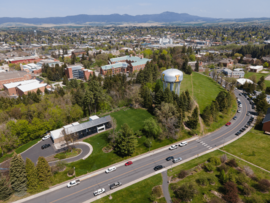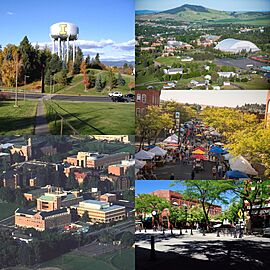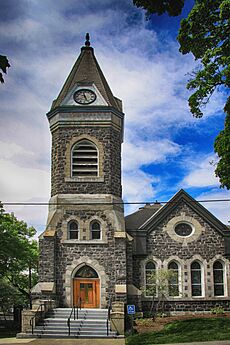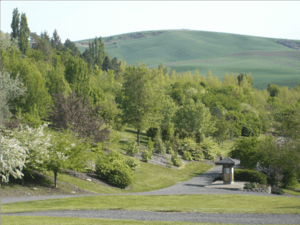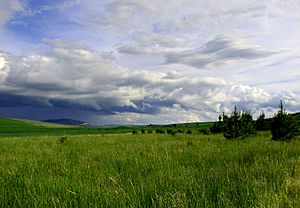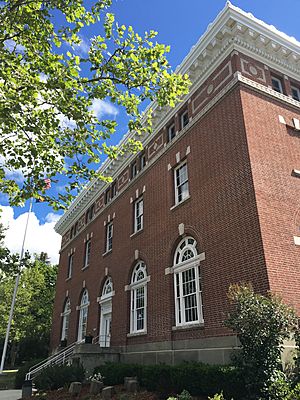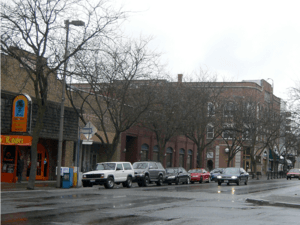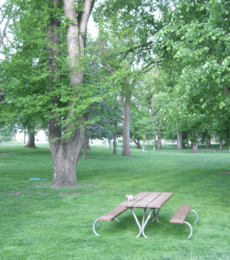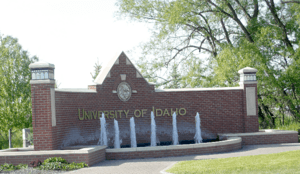Moscow, Idaho facts for kids
Quick facts for kids
Moscow, Idaho
|
|||
|---|---|---|---|
|
City
|
|||
|
Clockwise from top: Aerial view of Moscow, Kibbie Dome, Moscow Farmer's Market, Downtown Moscow, University of Idaho campus, water tower on campus
|
|||
|
|||
| Motto(s):
Heart of the Arts
|
|||
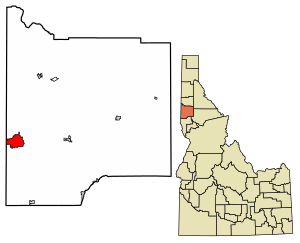
Location of Moscow in Latah County, Idaho.
|
|||
| Country | United States | ||
| State | Idaho | ||
| County | Latah | ||
| Settled | 1871 | ||
| Incorporated (town) | 1887 | ||
| Incorporated (city) | 1893 | ||
| Government | |||
| • Type | Mayor–council | ||
| Area | |||
| • Total | 6.91 sq mi (17.90 km2) | ||
| • Land | 6.91 sq mi (17.89 km2) | ||
| • Water | 0.00 sq mi (0.01 km2) | ||
| Elevation | 2,582 ft (787 m) | ||
| Population
(2020)
|
|||
| • Total | 25,435 | ||
| • Density | 3,720.08/sq mi (1,436.28/km2) | ||
| Time zone | UTC−8 (Pacific) | ||
| • Summer (DST) | UTC−7 (Pacific Daylight) | ||
| ZIP code |
83843
|
||
| Area code(s) | 208 | ||
| FIPS code | 16-54550 | ||
| GNIS feature ID | 2411172 | ||
| Website | ci.moscow.id.us | ||
Moscow (/ˈmɒskoʊ/ MOSS-koh) is a city and the county seat of Latah County, Idaho. Located in the North Central region of the state along the border with Washington, it had a population of 25,435 at the 2020 census. Moscow is the home of the University of Idaho, the state's land-grant institution and primary research university.
It is the principal city in the Moscow, Idaho Micropolitan Statistical Area, which includes all of Latah County. The city contains over 60% of the county's population, and whilst the university is Moscow's dominant employer, the city also serves as an agricultural and commercial hub for the Palouse region.
Along with the rest of the Idaho Panhandle, Moscow is in the Pacific Time Zone. The elevation of its city center is 2,579 feet (786 m) above sea level. Two major highways serve the city, passing through the city center: US-95 (north-south) and ID-8 (east-west). The Pullman–Moscow Regional Airport, four miles (6 km) west, provides limited commercial air service. The local newspaper is the Moscow-Pullman Daily News.
Contents
History
Miners and farmers began arriving in the northern Idaho area after the Civil War. The first permanent settlers came to the Moscow area 154 years ago in 1871. The abundance of camas bulbs, a favorite fodder of pigs brought by the farmers, led to naming the vicinity "Hog Heaven." When the first US post office opened in 1872, the town was called "Paradise Valley," but the name was changed to "Moscow" in 1875. The name Paradise persists with the main waterway through town, Paradise Creek, which originates at the west end of the Palouse Range, flows south to the Troy Highway, and west to Pullman where it enters the South Fork of the Palouse River.
The precise origin of the name Moscow has been disputed. There is no conclusive proof that it has any connection to the Russian city, though various accounts suggest it was purposely evocative of the Russian city or named by Russian immigrants. Another account claims that the name derives from a Native American tribe named "Masco". It was reported by early settlers that five men in the area met to choose a proper name for the town, but could not come to agreement on a name. The postmaster Samuel Neff then completed the official papers for the town and selected the name Moscow. Interestingly, Neff was born in Moscow, Pennsylvania and later moved to Moscow, Iowa.
The business district was established by 1875 and the town was a center of commerce for the region. By 1890, the Oregon Railroad and Navigation Company's rail line (later the Union Pacific) and the Northern Pacific railroad line helped to boost the town's population to 2000.
Alternative Note on Name and Early History
Copy of a letter from Northern Pacific Railway agent in Moscow, likely R.W. Morris, to C.E. Arney, the Northern Pacific's Western Immigration and Indian Agent in Spokane, Washington. Arney wrote all station agents in Idaho on May 12, 1922, requesting the origin of the names of their stations for the NP's travel publication Wonderland, edited by Olin D. Wheeler. Moscow's agent replied May 15, 1922, as follows:
"I called ex-Governor William J. McConnell [Republican, 1893-1897, 1839-1925], who was on the ground when the name was selected.
"He advises there is very little history in connection with the name. A Russian from Moscow, Russia, established a trading post here, where Moscow now stands, and they decided to name it Moscow after his native city in Russia.
"Previous to locating Moscow, there was a trading post about one mile southeast of here. The above mentioned Russian was successful in getting a post office here, and the trading post, which was known as Paradise Valley, was abolished.
"The surrounding country was known as Horse Heaven Country, account grass grew well, and the Indians grazed large herds of horses."
Original document at the University of Montana, Mike and Maureen Mansfield Library, K. Ross Toole Archives, Collection 178, Box 210, Folder 10.
The capital of the Idaho Territory was relocated from Lewiston to Boise in December 1864. In the late 1880s, statehood for the Washington Territory was nearing. Because its commercial and transportation interests looked west, rather than south, the citizens of the Idaho Panhandle passionately lobbied for their region to join Washington, or to form an entirely separate state, rather than remain connected with the less accessible southern Idaho. To appease the residents of the north, the territorial legislature of Idaho in Boise placed the new land grant university in Moscow, which at the time was the largest city other than Boise in the state. The University of Idaho was chartered in January 1889, and first opened its doors to students in October 1892.
In March 1890, Moscow's neighboring city, Pullman, was selected as the home of Washington's land grant institution. The college which became Washington State University opened its doors in January 1892. Washington entered the union as the 42nd state in November 1889 and Idaho entered next, eight months later, in July 1890.
Moscow City Hall and Old Post Office
Moscow Public Library
Members of the Pleiades Club and Ladies' Historical Club formed a cooperative named the Women's Reading Room Society and established a small library in the Browne building at the corner of Main and Second Streets in 1902.
In 1904, the committee planned to raise funds for a new library building. Andrew Carnegie promised funding of $10,000 if the community agreed to maintain a free public library at the rate of at least $1000 annually. Moscow voters approved a permanent tax in 1905 and with successful fundraising by subscription of local residents and businesses, coupled with the Carnegie library money, the library construction was begun in 1905. In March 1906, the Mission Style building was ready for occupancy. Later that month, a fire at the university's Administration Building totally destroyed that structure, so the new library was used for university classes during the day and residents used the library in the evening. Beginning in 1907 the building was returned to full use as a library. The original library building (which is on the National Register of Historic Places) was expanded in 1931 and 1983. It houses a children's room named for Moscow native Carol Ryrie Brink, the author of 1936 Newbery Medal winner Caddie Woodlawn.
In 2006, the Friends of the Library celebrated a Century of Service for the organization. The current organizational structure of library service encompasses all public libraries in Latah County as the Latah County Library District. The library enjoys broad support from the citizens of Moscow and the County and is also supported by the Idaho Commission for Libraries (formerly the Idaho State Library.) To commemorate the first century of the library, an essay competition was held. One young writer wrote:
We are fortunate enough to be able to walk a few blocks down to the public library and check out whatever we want. Libraries are valuable and available to everyone, regardless of wealth. Anyone can and everyone should get a library card. I am very grateful that we have a public library in Latah County.
—Elizabeth Nielsen (2006)
The Moscow Public Library currently houses about 60% of Latah County Library District's 100,000 volume collection. Administrative, technical, youth services, and branch services offices for the Library District are all housed at this location as well. The library offers year-round programming for all ages, including storytimes and a summer reading program for children, book clubs for teenagers and adults, and presentations by outside experts and organizations. The library also offers public Internet access computers as well as free wifi.
The library serves as resource for all the residents of Moscow, or as one essayist (Ellis Clark) in the 2006 contest states, "When time, money, or circumstances bind you to one locale, the Library is your passport for travel."
Changes
The opening of Moscow Mall (now Eastside Marketplace) and the Palouse Empire Mall (now Palouse Mall) in the late 1970s shifted many retail businesses away from the aging city center, with buildings dating to the 1890s. The city developed a revitalization project for downtown in the early 1970s that included a major traffic revision, which was enacted in 1981. Traffic from US 95 on Main Street was diverted a block away to one-way corridors on Washington (northbound) and Jackson (southbound) streets, to alleviate congestion and improve pedestrian safety and the overall city center experience. Main Street was converted from four busy lanes with metered parallel parking to two lanes of local retail traffic with free diagonal parking; its sidewalks were modified and trees were added. At the north end of Moscow, southbound highway traffic divided west at 'D' Street to Jackson and returned to Main at 8th; the northbound route divided east at 8th, but returned to Main four blocks earlier in the north end, at 1st Street.
The original 90-degree couplets used existing streets of the grid and were intended to be temporary, but remained for years. The primary safety hazard was inexperienced truck drivers; excessive speed through the tight corners led to toppled loads and subsequent traffic snarls, with occasional damage to adjacent structures. The new, straighter couplets at the north end are both over a block in length and eliminated existing structures. The return couplet from Washington Street runs from 1st Street to beyond 'A' Street; it eliminated the original front portion (white stucco chapel) of the Corner Club tavern at the northeast corner of 'A' and Main, which was demolished in early 1991 after staving off its elimination for over a decade. The building on the southeast corner, the Idaho Hotel, built in 1890, was razed for the traffic project in 1977 and was a vacant lot for over a decade.
The first of the new couplets was completed during the summer of 1991. The new southbound couplet to Jackson Street was completed the following year in 1992 and begins north of 'C' Street. It eliminated a former service station at the northwest corner of 'C' and Main, which had been converted to other retail for over a decade. The critical couplet at the south end of the city was delayed several times for various reasons. Completed in 2000, it is two blocks south and one block east of the 1981 divider at 8th Street. After Sweet Avenue, northbound Main Street bends a block east to align with northbound one-way Washington Street, intersecting the two-way Troy Highway from the southeast. Southbound US 95 traffic joins the intersection from the northwest, arriving on a one-way diagonal from Jackson Street. Agricultural buildings on the block between Jackson and Main (College St. to Lewis St.) were razed in the late 1990s to complete this new corridor.
Another significant change to local commerce was the increase of the state's legal drinking age to 21 in April 1987, after nearly fifteen years at age 19. Many establishments that relied on revenues from 19- and 20-year-olds from the two university communities had to adjust or cease operations. Prior to the lowering to 19 in July 1972, the drinking age in Idaho was 20 for beer and 21 for liquor and wine.
A fixture of the Moscow skyline for nearly a century, the concrete grain elevators on south Main Street were demolished in March 2007. Located on the southwest corner of 8th & Main, the elevators were last operated by the Latah County Grain Growers. The other major concrete elevator complex, on Jackson Street south of 6th, was also slated for the wrecking ball. Idle since 2005, it was saved by a preservationist group in 2007. Its newer large-diameter metal silo hosted summer theater productions in 2011.
Geography
Main Street runs north–south through Moscow along the 117th meridian west.
According to the United States Census Bureau, the city has a total area of 6.85 square miles (17.7 km2), all of it land.
Moscow lies on the eastern edge of the Palouse region of north central Idaho in the Columbia River Plateau. East of the city is a valley within the mountains of the Palouse Range to the northeast, whose highest point is Moscow Mountain at 4,983 feet (1,519 m) above sea level. The less prominent Paradise Ridge at 3,702 feet (1,128 m) and Tomer Butte at 3,474 feet (1,059 m) are southeast of the city. Paradise Creek, with headwaters on Moscow Mountain to the northeast, flows through Moscow, then crosses the state border and joins the south fork of the Palouse River near Pullman, which eventually drains into the Snake River and Columbia River on its way to the Pacific Ocean.
The geology in and around Moscow represents varied formations: very old intrusive granite structures of the Jurassic−Eocene Idaho Batholith, fertile fields atop rolling hills of deep Pleistocene loess of the Palouse Formation deposited after the last ice age by westerly winds, and flood-worn channels of the Columbia River Basalt Group.
There is a variety of flora and fauna within the vicinity of Moscow. An amphibian, the Rough-skinned Newt, has a disjunctive population at Moscow; this species is found typically along the Pacific coast of the US. The city sits at the boundary between the Palouse grasslands and wheat fields, and the conifer forests of the Rocky Mountains to the east.
Climate
According to the Köppen climate classification system, Moscow has either a warm-summer Mediterranean climate (Csb) or a dry-summer continental climate (Dsb).
| Climate data for Moscow, Idaho (University of Idaho), 1991–2020 normals, extremes 1893–present | |||||||||||||
|---|---|---|---|---|---|---|---|---|---|---|---|---|---|
| Month | Jan | Feb | Mar | Apr | May | Jun | Jul | Aug | Sep | Oct | Nov | Dec | Year |
| Record high °F (°C) | 58 (14) |
66 (19) |
73 (23) |
88 (31) |
94 (34) |
105 (41) |
105 (41) |
109 (43) |
100 (38) |
88 (31) |
73 (23) |
61 (16) |
109 (43) |
| Mean maximum °F (°C) | 49.5 (9.7) |
53.5 (11.9) |
64.6 (18.1) |
74.8 (23.8) |
83.2 (28.4) |
88.6 (31.4) |
96.6 (35.9) |
98.2 (36.8) |
91.9 (33.3) |
78.3 (25.7) |
60.2 (15.7) |
49.4 (9.7) |
99.1 (37.3) |
| Mean daily maximum °F (°C) | 37.4 (3.0) |
42.0 (5.6) |
50.1 (10.1) |
58.0 (14.4) |
67.3 (19.6) |
73.4 (23.0) |
84.4 (29.1) |
85.6 (29.8) |
76.2 (24.6) |
60.5 (15.8) |
44.9 (7.2) |
36.4 (2.4) |
59.7 (15.4) |
| Daily mean °F (°C) | 29.8 (−1.2) |
32.9 (0.5) |
39.0 (3.9) |
45.0 (7.2) |
52.6 (11.4) |
57.7 (14.3) |
64.9 (18.3) |
65.4 (18.6) |
57.9 (14.4) |
46.6 (8.1) |
36.2 (2.3) |
29.0 (−1.7) |
46.4 (8.0) |
| Mean daily minimum °F (°C) | 22.2 (−5.4) |
23.8 (−4.6) |
28.0 (−2.2) |
32.0 (0.0) |
37.9 (3.3) |
42.0 (5.6) |
45.3 (7.4) |
45.2 (7.3) |
39.7 (4.3) |
32.8 (0.4) |
27.4 (−2.6) |
21.6 (−5.8) |
33.2 (0.6) |
| Mean minimum °F (°C) | 4.2 (−15.4) |
9.8 (−12.3) |
16.8 (−8.4) |
24.9 (−3.9) |
28.2 (−2.1) |
33.7 (0.9) |
37.3 (2.9) |
36.2 (2.3) |
29.0 (−1.7) |
20.1 (−6.6) |
13.2 (−10.4) |
5.7 (−14.6) |
−4.8 (−20.4) |
| Record low °F (°C) | −26 (−32) |
−26 (−32) |
−10 (−23) |
11 (−12) |
19 (−7) |
28 (−2) |
31 (−1) |
30 (−1) |
20 (−7) |
2 (−17) |
−14 (−26) |
−42 (−41) |
−42 (−41) |
| Average precipitation inches (mm) | 3.33 (85) |
2.56 (65) |
3.05 (77) |
2.75 (70) |
2.60 (66) |
1.73 (44) |
0.66 (17) |
0.70 (18) |
1.01 (26) |
2.40 (61) |
3.52 (89) |
3.47 (88) |
27.78 (706) |
| Average snowfall inches (cm) | 14.5 (37) |
8.6 (22) |
4.9 (12) |
1.0 (2.5) |
0.2 (0.51) |
0.0 (0.0) |
0.0 (0.0) |
0.0 (0.0) |
0.0 (0.0) |
0.2 (0.51) |
6.0 (15) |
15.5 (39) |
50.9 (128.52) |
| Average extreme snow depth inches (cm) | 9.0 (23) |
5.3 (13) |
2.5 (6.4) |
0.1 (0.25) |
0.0 (0.0) |
0.0 (0.0) |
0.0 (0.0) |
0.0 (0.0) |
0.0 (0.0) |
0.0 (0.0) |
2.5 (6.4) |
7.0 (18) |
11.7 (30) |
| Average precipitation days (≥ 0.01 in) | 16.0 | 13.9 | 15.5 | 13.4 | 11.4 | 9.3 | 4.4 | 3.6 | 5.5 | 10.9 | 16.1 | 15.9 | 135.9 |
| Average snowy days (≥ 0.1 in) | 6.3 | 5.0 | 3.2 | 1.1 | 0.3 | 0.0 | 0.0 | 0.0 | 0.0 | 0.3 | 3.2 | 7.8 | 27.2 |
| Source 1: NOAA | |||||||||||||
| Source 2: National Weather Service | |||||||||||||
Demographics
| Historical population | |||
|---|---|---|---|
| Census | Pop. | %± | |
| 1880 | 76 | — | |
| 1890 | 1,280 | 1,584.2% | |
| 1900 | 2,484 | 94.1% | |
| 1910 | 3,670 | 47.7% | |
| 1920 | 3,956 | 7.8% | |
| 1930 | 4,476 | 13.1% | |
| 1940 | 6,014 | 34.4% | |
| 1950 | 10,593 | 76.1% | |
| 1960 | 11,183 | 5.6% | |
| 1970 | 14,146 | 26.5% | |
| 1980 | 16,513 | 16.7% | |
| 1990 | 18,519 | 12.1% | |
| 2000 | 21,291 | 15.0% | |
| 2010 | 23,800 | 11.8% | |
| 2020 | 25,435 | 6.9% | |
| U.S. Decennial Census 2020 | |||
2010 census
As of the census of 2010, there were 23,800 people, 9,180 households, and 4,335 families residing in the city. The population density was 3,474.5 inhabitants per square mile (1,341.5/km2). There were 9,879 housing units at an average density of 1,442.2 per square mile (556.8/km2). The racial makeup of the city was 90.9% White, 1.1% African American, 0.6% Native American, 3.1% Asian, 0.2% Pacific Islander, 1.4% from other races, and 2.7% from two or more races. Hispanic or Latino of any race were 4.6% of the population.
There were 9,180 households, of which 22.9% had children under the age of 18 living with them, 37.8% were married couples living together, 6.1% had a female householder with no husband present, 3.4% had a male householder with no wife present, and 52.8% were non-families. 31.3% of all households were made up of individuals, and 6.6% had someone living alone who was 65 years of age or older. The average household size was 2.26 and the average family size was 2.91.
The median age in the city was 24.2 years. 16.4% of residents were under the age of 18; 36.1% were between the ages of 18 and 24; 24.7% were from 25 to 44; 15.6% were from 45 to 64; and 7.4% were 65 years of age or older. The gender makeup of the city was 51.8% male and 48.2% female.
Arts and culture
The city was highlighted in a comedy special at University of Idaho by actor-comedian Yakov Smirnoff, filmed in late 1990. Using Moscow as its setting pokes fun at Smirnoff emigrating from Moscow, Russia.
| Name | Dates | Location | Notes |
|---|---|---|---|
| Lionel Hampton Jazz Festival | April, second to last weekend | Multiple venues | Main concerts: Idaho Central Credit Union Arena |
| Moscow Hemp Fest | April, mid-month | East City Park | |
| Renaissance Fair | May, first weekend | East City Park | Multiple stages and events |
| Farmers Market | May–October, Saturdays | Main Street | 8am - 1pm |
| Rendezvous in the Park | July, third week | East City Park | |
| Light up the Night Parade | December 1 | Main Street |
Parks and recreation
There are seventeen neighborhood parks located throughout the town offering a wide variety of venues for outdoor activities. These parks fall under the jurisdiction of the Moscow Parks and Recreation Department. The Moscow Pathways Commission (formerly Paradise Path Task Force) is a citizen committee seeking to develop a system of linearly connected parks throughout the area. Carol Ryrie Brink Nature Park was a community collaboration between the Palouse Clearwater Environmental Institute and local volunteers to remeander Paradise Creek and add riparian plantings. The Moscow community, including schools and the city, led by local youth, raised money over several years to fund, design, and build a skate park that was completed in 2000. A park just north of the university is named for Admiral Robert Ghormley, from 1933 to 1997, it was the site of the city's outdoor swimming pool. Its replacement, the Hamilton-Lowe Aquatics Center in northeast Moscow, opened in June 2000.
The Latah Trail, completed in October 2008, extends from the eastern edge of Moscow bike path system to Troy, parallel to the Troy Highway (SH-8) for most of its twelve miles (19 km). On the west side of Moscow, the Bill Chipman Palouse Trail connects the two university communities of the Palouse. Starting at the University of Idaho's Perimeter Road, it gradually descends with Paradise Creek for eight miles (13 km) to Pullman through Whitman County, alongside the Moscow-Pullman Highway. Completed in April 1998, the trail honors a Pullman businessman (and UI alumnus) who died two years earlier, following a winter highway accident in Spokane County. The Paradise Path bridges the gap in Moscow between the endpoints of the Chipman and Latah trails, passing through the north and east edges of the UI campus. The trail systems together constitute a continuous 22-mile (35 km) paved linear park from Pullman to Troy, extending in Troy beyond the eastern boundary of the Palouse ecosystem. From Pullman to the western boundary of Moscow (the state line), it follows the right of way of a dismantled Union Pacific railroad line, and east of US-95 it follows the right of way of a dismantled BNSF railroad line that junctioned at Arrow on the Clearwater River by way of Troy, Kendrick, and Juliaetta.
The defunct Tamarack Ski Area was on the east-facing slope of East Moscow Mountain; a grove of ancient red cedar trees is nearby, just northeast of Moscow Mountain's summit.
Education
Higher education
The University of Idaho (officially abbreviated "U of I") is Idaho's oldest public university, located in the city of Moscow in Latah County in the northern portion of the state. It is the state's flagship, land-grant, and primary research university. The University of Idaho was the state's sole university for 71 years, until 1963, and its College of Law, established in 1909, was first accredited by the American Bar Association in 1925.
Formed by the territorial legislature on January 30, 1889, the university opened its doors in 1892 on October 3, with an initial class of 40 students. The first graduating class in 1896 contained two men and two women. It presently has an enrollment exceeding 12,000, with over 11,000 on the Moscow campus. The university offers 142 degree programs, including bachelor's, master's, doctoral, and specialists' degrees. Certificates of completion are offered in 30 areas of study. At 25% and 53%, its 4 and 6 year graduation rates are the highest of any public university in Idaho, and it generates 74% of all research money in the state, with research expenditures of $100 million in 2010 alone.
As a land-grant university and the primary research university in the state, UI has the largest campus in the state at 1,585 acres (6.4 km2), located in the hills of the Palouse region. The school is home to the Idaho Vandals, who competed on the Division I FBS (formerly I-A) level through the 2017 season before dropping down to the FCS level in 2018. In addition to the main campus in Moscow, the UI has branch campuses in Coeur d'Alene, Boise, Twin Falls, and Idaho Falls. It also operates a research park in Post Falls and dozens of extension offices statewide.
New Saint Andrews College opened in 1994 and moved to its present campus on Main Street in 2003.
Primary and secondary education
The Moscow School District #281, which covers the entire city limits, operates Moscow High School (9-12), an alternative high school, a middle school (6-8), and four elementary schools (two K-5, one K-2, one 3–5).
There are two public charter schools and three private schools in the city.
High school
- Moscow High School (9–12)
Alternative High School
- Paradise Creek Regional High School (10–12)
Middle school
- Moscow Middle School (6–8)
- Palouse Prairie Charter School (K–8)
Elementary schools
- Lena Whitmore Elementary School (K–5)
- A.B. McDonald Elementary School (K–5)
- John Russell Elementary School(Closed since 2024) (3–5)
- West Park Elementary School (K–2)
- Palouse Prairie Charter School (K–8)
Infrastructure
Transportation
Highways
US-95 connects Moscow to Coeur d'Alene, Lewiston, and the Treasure Valley with onward connections to Boise. ID-8 runs east–west through Moscow and travels to Pullman in the west and Troy to the east.
Airports
Pullman–Moscow Regional Airport is 4 miles (6 km) west, just east of the Washington State University campus. Other nearby airports are the Lewiston-Nez Perce County Airport, 34 miles (55 km) south, and Spokane International, 90 miles (140 km) north.
Rail and bus service
The Moscow Intermodal Transit Center is the transport hub for SMART (Sustainable Moscow Area Transit Service) transit and intercity bus services. Bus service to Spokane and Boise is offered by Northwestern Trailways. Wheatland Express also provides service to Spokane.
Bicycles
The Paradise Path is an east-to-west multi-use path that connects to shopping centers, the University of Idaho, and city parks. A small network of bike lanes and sharrows connects the Paradise Path to downtown and residential areas to the east. There are intercity bike trail connections with the Bill Chipman Palouse Trail to Pullman, Washington and the Latah Trail to the eastern town of Troy.
Notable people
- Shanin Blake (born 1994), pop singer, artist, influencer and model
- Carol Ryrie Brink (1895–1981), author
- Bryce Callahan (1991–), Former NFL cornerback, with the Chicago Bears and the Denver Broncos
- Joel Courtney (1996–), actor
- Darren Doane (1972–) filmmaker and music video director
- Hec Edmundson (1886–1964), basketball and track coach, state's first Olympian (1912)
- Burton L. French (1875–1954), congressman from Idaho for 26 years
- Jackson Gillis (1916–2010), screenwriter
- Abe M. Goff (1899–1984), congressman (1947–49), served in military in both world wars
- Shay Hatten (1993-), screenwriter and film producer
- Samuel D. Hunter (1981–), playwright, 2014 MacArthur Fellowship recipient
- Robert Jessup (1952–), artist
- Kelli Johnson, news anchor for NBC Sports Bay Area
- Lawrence H. Johnston (1918–2011), Manhattan Project physicist
- Luke Kruytbosch (1961–2008), thoroughbred horse racing announcer
- Andrea Lloyd-Curry (1965–), retired women's basketball player, Olympic gold medalist
- Tom McCall (1913–83), Governor of Oregon (1967–75), Moscow newspaper reporter (1937–42)
- William J. McConnell (1839–1925), Governor of Idaho (1893–97), father-in-law of Senator William Borah
- Dan Monson (1961–), college basketball coach
- James C. Nelson, attorney and former Justice of the Montana Supreme Court
- Dan O'Brien (1966–) Olympic and world champion decathlete; Moscow resident (1984–1997)
- Malcolm Renfrew (1910–2013), chemist and author of the first scientific papers on Teflon
- Doug Riesenberg (1965–), retired NFL lineman, Super Bowl champion
- Josh Ritter (1976–), singer-songwriter and author
- Frank B. Robinson (1886–1948), founder of spiritual movement, Psychiana
- Lyle Smith (1916–2017), football coach and athletic director at Boise State
- Willis Sweet (1856–1925), Idaho's first congressman after statehood (1890–95)
- Paul Wheaton, permaculture theorist, software engineer
- Douglas James Wilson (1953–), theologian
- N. D. Wilson (1978–), author
- Jonathan M. Woodward (1973–), stage and screen actor
Sister city
Moscow has one sister city, as designated by Sister Cities International:
 Villa Carlos Fonseca, Nicaragua
Villa Carlos Fonseca, Nicaragua
See also
 In Spanish: Moscow (Idaho) para niños
In Spanish: Moscow (Idaho) para niños


